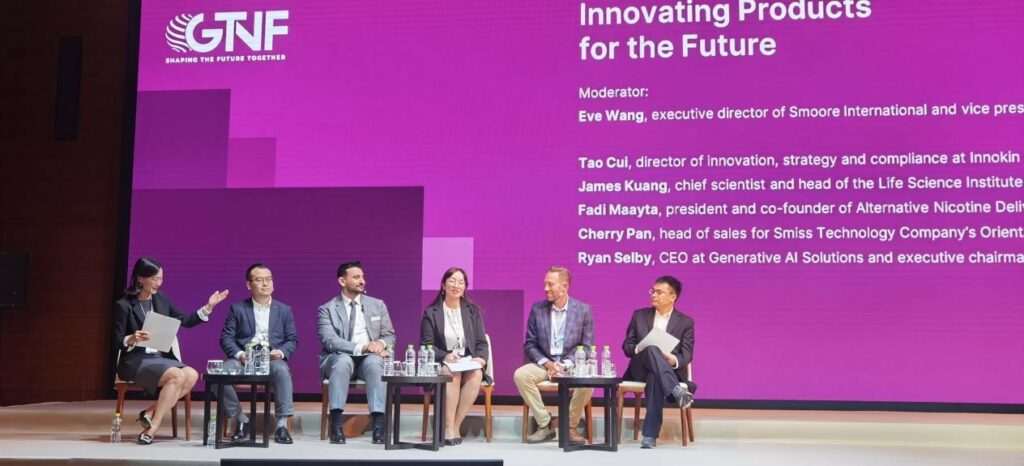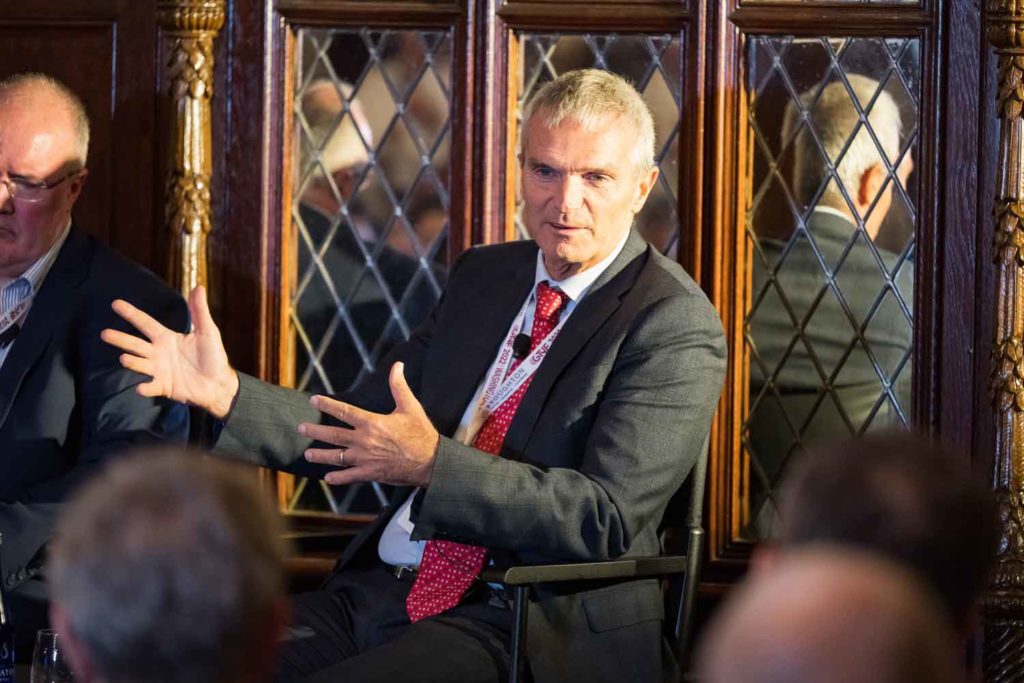
The Fireside Chat with Robert Pye, CEO of Filtrona, Luis Sanches, chief strategy officer at Greenbutts, and Chris Greer, president and CEO of TMA, offered insights into the environmental, social and governance (ESG) framework.
The chat started with a discussion of each company and what it does within the larger industry—Filtrona and Greenbutts are both in the filters aspect of the industry in different manners. Filtrona is a traditional and specialty filter supplier while Greenbutts is a material science company that has been working to introduce a more sustainable alternative to traditional cellulose acetate filters. While Filtrona has been in the industry for 80 years, Greenbutts is relatively new at 13—“a startup of sorts,” in the words of Greer.
Greer noted that Filtrona has many locations in Asia, with the headquarters being in Singapore, and brought up the idea of the 21st century being “the Asian century.”
“What attracted you to Singapore, first, and for your part of the industry, what are some key takeaways that you can give us about Asia and the marketplace and where that fits in, in the change and transformation part of things?” Greer asked Pye.
“I think Asia is, as you mentioned, a very dynamic place,” Pye said. “Our global head office is based in Singapore. We’re happily ensconced there because, I think if you think about our 2,000 employees, probably in Asia, we have maybe 1,500 of those 2,000 employees based in Asia. So it just makes sense to be in Singapore. And also our largest part of revenue and profits are based in Asia as well.
“So it just made sense for us to really base ourselves in Asia and really base our footprint around Asia. And the reason for being based around Asia is really that we see this being the most dynamic part of the industry for our industry as well. We see a lot of companies coming to Asia. Indonesia has had probably a lot of expansion over the last few years. That market’s still very interesting. Of course, I mentioned the China market, but India’s still interesting. And then you’ve got all the Southeast Asian countries, and they’re all very different, right? Whether they’re regulations or whether they’re cultural aspects or even tobacco-related industries within that country.”
Pye also expressed that Asia is willing to advance “whether it’s technology or whether it’s a market or whether it’s embracing something new.” He said countries “probably less developed than some other Western countries usually tend to leapfrog in a lot of areas of technology.”
Turning to Sanches, Greer said, “You’re in material science, you’re blazing your trail. What’s the biggest change that you’ve had to make in your thinking?” Sanches joined Greenbutts from BAT, a large company with lots of resources.
“It’s an interesting consideration,” Sanches said. “Because I think for a gearbox perspective, every company, regardless of its size, it needs the core to be properly functioned. For instance, you need to define your goals. … And regardless if you’re in startup, the organization needs to have this very well defined. Then you set up a strategy, and the strategy has to be the way you want to deliver those goals. And then you move to metrics, and then you move to engagement, primarily to whom you need to partner with and which organizations you need to be very close [with], the shareholders you need to bring to your organization, the stakeholders that get affected or being affected by you.
“So I think, in a sense, we share the same values. I think we share the same structure. … I think the biggest differences will be the size of the pocket for sure. Being part of a startup, funds and resources are not always there. So it’s more limited in terms of resources and talent footprint that Robert just mentioned. I think the other aspect is big organizations; they have very good governances. They sometimes, and most of them, they’re very bureaucratic. And the politics inside organizations drive you crazy and slow you down in every decision you need to make,” Sanches said. He noted that a big advantage to being a startup is flexibility.
Greer noted that ESG sometimes gets a “bad rap” as a buzzword and, in the spirit of changing the conversation, asked Pye and Sanches to talk about the real work behind ESG. “We see it in our business as being very important,” said Pye. “We want to be part of the solution. We see it makes great business sense, and we also see it makes great moral sense. You have a morality to it that you can flag and engage with your employees and your customers.”
“We are the largest producer of sustainable filters globally,” Pye continued. “I can sit on the stage and say that quite confidently. We work with all of the major suppliers in that area. We work with all the latest think tanks in that area, such as Greenbutts. But we also work with all the large customers and some small customers as well.
“We are a zero waste to landfill business. Any waste we generate, we use it to generate steam for our products.” Pye also noted that one of Filtrona’s sites has zero emissions and that the company uses solar panels on many of its sites as well.
Sanches added to that, noting that he made it clear in his early days with Greenbutts that the company could not “be seen as disruptors because disruption implies chaos” and the tobacco industry is a very efficient machine, so the company should focus on helping the industry transform itself without disrupting it.
“When we establish this as a premise in our ways of working, we say we need to ensure that the entire value chain is covered. We’re going to do the pre-work, ensure that we have all the sources of the material that you utilize well set up in a proper geography. The converters which convert fibers into substrate are well set up as well in a global scale. … Therefore, when the tobacco industry decides to adopt this or the biodegradable filters as their future solution today, we are all set up. So, not chaotic, not disruptive, but in a very gentle and very smooth way that we can introduce this.”
According to Sanches, Greenbutts aims to have the value chain covered so that companies can focus on other aspects. “We can help them in delivering their ESG targets,” he said.
The fireside chat highlighted what ESG looks like with tangible products and outcomes and pivoted the conversation away from targets toward real results.







































